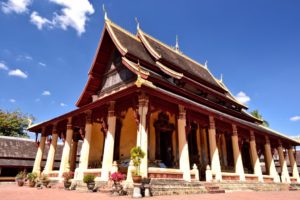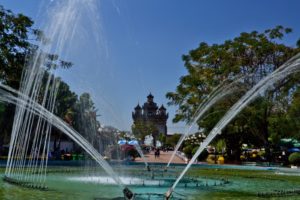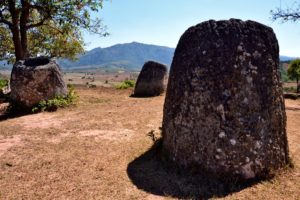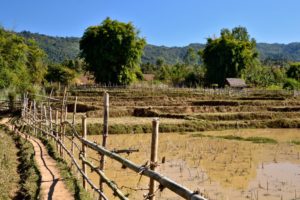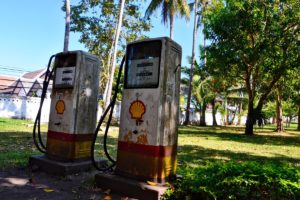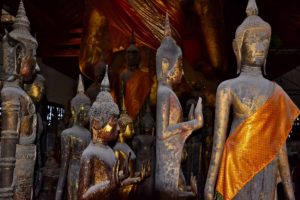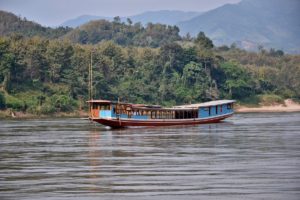
Laos Travel Tips
How to get to Laos from Vietnam
We arrived in Laos after a short flight from Hanoi. We initially planned to take a bus to cross the border between Vietnam and Laos but due to Tet celebration in Vietnam, no travel agency was able to arrange the respective bus tickets.
Vientiane
The capital Vientiane with a population of approx. 320,000 is relatively small and most sights are reachable within a short walk from the city center. Vientiane contains many Buddhist temples all over the city center. Monks in orange robe can be seen the whole day walking through Vientiane’s streets.
The Buddhist stupa of That Luang is one of the most famous in Laos. The golden stupa is about 45 meters tall and was originally built in 1566.
The memorial monument Patuxai was constructed between 1957 and 1968. The architecture reminds of the Arc de Triomphe in Paris but the design incorporates typical Lao motifs. We had a nice view on Vientiane from the top of this building.
Buddha Park near the Thailand Boarder
After a one hour drive with a local bus, we reached a park with a big collection of Buddhist and Hindu sculptures. This park was built in 1958 by a priest. The park is very close to the border with Thailand. After the priest fled to Thailand due to repercussions, he built a similar park in Thailand – also very close to the border so that both parks are just a few kilometers apart from each other. 

Our impressions about Laos and bus service
Laos is a very relaxing country: the people are all very friendly to us (probably due to less tourism), the prices for buses, excursions and other things like laundry are the same all over one city and the traffic is very unstressed with a convenient number of cars and motorcycles and even Tuk Tuks are rare. We were very surprised seeing a car stopping at the cross walk. Never have seen this in any Asian country before. Especially compared to Laos’ neighbors Vietnam and Cambodia, we do not feel rushed by the traffic and also honks are not used here. However, the bus system is chaotic apart from the prices that are exactly the same in all travel agencies. We have booked a touristic bus to go to the mountains in a ten hour journey but ended up in a local bus. This bus pick up people from the street and stopped at almost every small market. And we have experienced that Asians can’t stand twisting rides on rather bad roads in a bus. We were the only tourists on this bus and have created a little mess: We have recognized this as the guy sitting in the last row was screaming since he got wet and didn’t know what it was. Then the girl in the first row also started to scream. First, we thought that this could be our glass beer bottle stored in the top tray that broke due to the turbulences in the bus. But it looked like water and so we didn’t worried further. The driver’s assistant started wiping up the package tray and searched for the root cause. But this was no reason for the driver to stop driving and so the assistant was jumping in the bus due to the bad condition of the roads. He found one bag with a lot of water in it and asked in Lao who the owner of this bag is. Unbelievable, but this was really our bag but we were looking outside the window and pretended not to understand the issue… 🙂 
Phonsavan
Arrived in the mountains in Phonsavan we were happy about the moderate temperature (only around 22 degrees Celsius – compared to the 33 degrees Celsius we have for six weeks now) due to being 1,100 meters above sea level. One of the main sights in this area is the Plain of Jars. We were surprised seeing so many tourists up there, so it seems more people are attracted by this fascinating mysterious sight. The Plain of Jars is an archaeological landscape with thousands of stone jars scattered around the valleys. They have been there for thousands of years, grouped together in clusters and their purpose is still a mystery. Similar jars have also been discovered in India and Malaysia. The jars in Laos can be dated back to the Iron Age. Many of them were destroyed in the Vietnam War in the 1960s and 1970s where Americans bombed this area as part of their attacks on Vietnam. Only three jar sites are open for visitors due to the many unexploded bombs that are still be found in this area. The big question is: For what were the jars used? The most common theories are the following: 1. Jars were used for collection the rain water for travelers during the monsoon season to cater for the dry season. 2. Jars were used to brew rice wine and beer by giants or 3. Jars were used for funerals. The latter one is the most widely accepted theory since human bones have been discovered at the jar sites. We have rented a motorcycle to visit all three sites. Site 1 is just a short drive from Phonsavan. This is with around 300 jars the most visited site. The jars vary in size and range from half a meter until around three meters. The heaviest jar weights around six tones.
Jar site 2 offers a smaller amount of jars on hills on two sides of the adventurous road we had to take to get there. One of the jar had tree roots growing out of it and it reminded us of the power of the nature we have already seen at Angkor with the temples surrounded by trees.
Jar site 3 is just a small ride away from Jar site 2. To get to the jars we had to cross rice fields up a small hill. This site was the most impressive for us due to the many good maintained jars in a rather small area.
You might think that we are crazy spending one day visiting stone jars but we really enjoyed the driving around by our own and stopping everywhere and at every time to walk around and to take pictures. To get from Phonsavan to Luang Prabang we took again a mini bus. It was very comfortable but the seats in the middle are interesting on these bumbling roads.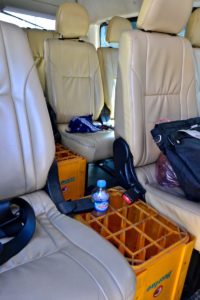
Luang Prabang
Until we arrived in Luang Prabang we thought Laos is “okay” but not a highlight of our trip. But Luang Prabang changed completely our mind and we think that Luang Prabang is one of the most fascinating city in Southeast Asia with its ancient charm of the French colonial houses and the many Lao monasteries at every corner of the city as well as the astonished monks’ morning ceremony. We have not imagined such kind of a city from a poor country, however you cannot really call it city since it is rather a small town. The French impact is still visible in the streets with the nice cafes (incl free WiFi) and the smell of fresh baguette and croissants. From our point of view, we can confirm that Luang Prabang is indeed “the jewel of Indochina” and it complies with this pretty big title.
Tak Bat – morning monk procession
But let’s start from the beginning to tell you why we are intoxicated by this city. Tak Bat – how the morning alms procession is called – is a very beautiful ritual taking place in the dawn every morning. Monks are floating through the empty streets, collecting sticky rice from the devoted. It is a form of a meditation for the buddhists and an act of respect. The whole ceremony takes about one hour and the locals give small gifts to the monks, mainly rice, fruits or sweets. Participating in this ceremony felt to us like a privilege and it was a big moment. We bought a basket full with sticky rice, dressed with a scarf over one shoulder and sit down on the road waiting for the monks. They are coming in huge groups and I had issues forming small portions of this really sticky rice and to put into their steaming bowl. So a crowd of monks were standing in front of me like a traffic jam.
We read about the Tak Bat in the internet before going there and found a lot of examples of bad behavior of tourists during the ceremony. The first day participating in the ceremony on the non-touristic side of the Mekong over was really amazing and the small number of other tourists were only taking pictures from a distance. However, the next day we went to the city center to watch the ceremony. And what we have seen there was really shocking us: tourists standing directly in front of the monks and taking pictures with flash and lights to see better in the dark. Some also stopped the monks in their ceremony to have a good shot. How awful! It was already embarrassing seeing the signs for tourists in the monasteries how to behave during Tak Bat – is this really necessary I thought, but after we have seen how some tourists are not able to pay respect to the monks and believe that this is a circus or a zoo, there cannot be enough signs. The same happened when we went up a hill to a temple viewing the sunset: tourists were climbing up the stupa in order to have a better view. Even though one guide told them to go down, they started arguing. How embarrassing! In the afternoon, we met a novice (monk) in a temple and he started chatting with us. So, we took the chance to ask him some questions. The monks (darker color of scarf) really only eat once per day, the novices (light colored scarf) twice. Some eat the sticky rice received in the Tak Bat really pure without anything else and some in soup or even with meat. But they are also happy when they receive sweets in the morning ceremony. Many do something with tourism after leaving the monastery since they learn languages, especially English and French, during their time in the temple.  We spent two full days walking through the charming town visiting the main temples and some other sights. The Xieng Thong temple was built mid of the 16th century and is considered as a classic example of a Laotian temple with the several layers of roofs and the colorful facades.
We spent two full days walking through the charming town visiting the main temples and some other sights. The Xieng Thong temple was built mid of the 16th century and is considered as a classic example of a Laotian temple with the several layers of roofs and the colorful facades.
The first temple we saw when we arrived in Luang Prabang was the one on top of the Phu Si hill. 328 steps lead to the golden stupa on top with Buddhas in various positions along the stairs. From there, we viewed the sun going down over the Mekong River.
We continued to the National Museum of Luang Prabang. But this is not a classical museum with old statues and bowls, it is rather the former royal palace. The interior inside looks similar to what we have seen in the temples and the car collection consist of presents from the Japanese (Toyota) and American (Lincoln) governments. Unfortunately, taking pictures inside was not allowed – also not of the old cars. I found that the most fascinating aspect of this museum is the gift collection showing presents from other nations. Not as big as the one we visited (better: had to visit) in North Korea but interesting that Myanmar and Cambodia have brought very similar tea silver pots and cups. The Polish government offered a letter opener and the USA a piece of the moon.
The oldest monastery Visounarath in Luang Prabang was founded in 1512 by the Lao king and is currently renovated. The windows look like the ones we have seen in Angkor in Cambodia and inside is a museum with several Buddhas including some with for Luang Prabang typical position with arms at the side of the body wishing rain.
Kuang Si waterfalls
One of the main attractions outside of Luang Prabang are the Kuang Si waterfalls. We have rented a motorcycle again for one day to get there. The water is completely clear, running over several steps and walking up to the source of the waterfall was a nice challenge.
On the way back from the waterfalls to Luang Prabang we stopped at a small elephant sanctuary. Unfortunately, this was one that still uses the former working elephants for trekking tours with tourists but we were able to get very close to the elephants and to feed them – what is a must do in the country of which the name means “millions of elephants”.
With the slowboat from Laos to Thailand on the Mekong River
To get to our next destination Thailand, we took a slow boat from Luang Prabang to cruise along the Mekong River towards to Thai-Lao border. The boat takes two days for the 300 km and it was a very pleasant and relaxing journey. We enjoyed the beautiful landscape along the Mekong River.
Pak Beng
The overnight stop on our slow boat tour was in Pak Beng – a village that mainly lives from the tourists coming for a one-night-stopover on the slow boat tours.  On the way, we stopped at the Pak Ou cave that is populated with many small Buddha statues. The story is more interesting than the pictures: These privately owned statues have been brought to the cave to protect against sacking during the Indochina war.
On the way, we stopped at the Pak Ou cave that is populated with many small Buddha statues. The story is more interesting than the pictures: These privately owned statues have been brought to the cave to protect against sacking during the Indochina war.
On the second day we stopped at a traditional Lao village. 17 families with around 100 people are living in this village. The houses are made of bamboo without any windows. Every village has a school with English lessons. Visiting this village was like a journey to the past since every village in Laos looked formerly like this one.
The Mekong River is one of the longest rivers in the world and connects the six countries China, Thailand, Cambodia, Myanmar, Vietnam and Laos. On the last kilometers of our cruise, Thailand was already visible on the left hand side and Laos still on the right hand side. We recognized the difference in the wealth between these countries through different style of houses: Thailand’s house are built from cement and Laos’ one are basic and made of wood. For the sake of completeness, below our route through Laos (however, the route along the Mekong River is not shown correctly due to limitation of google to only select one kind of vehicle): 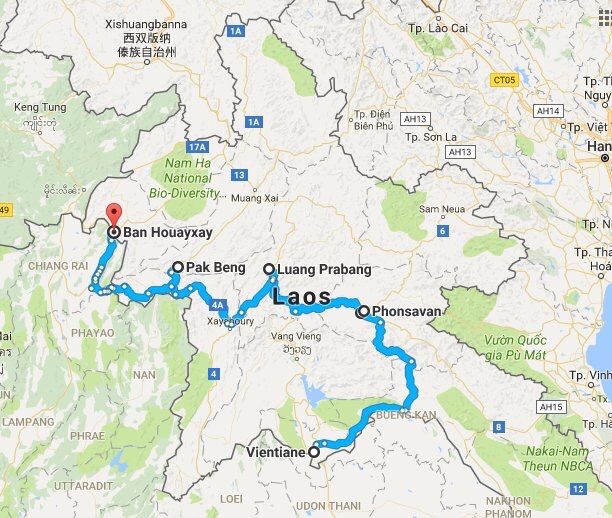
Explore further countries:
Continue reading our most popular blogs:
- Our travel packing list
- Slovenia and Austria travel tips
- Georgia travel tips
- New Zealand travel tips
- North Korea (DPRK) travel tips
